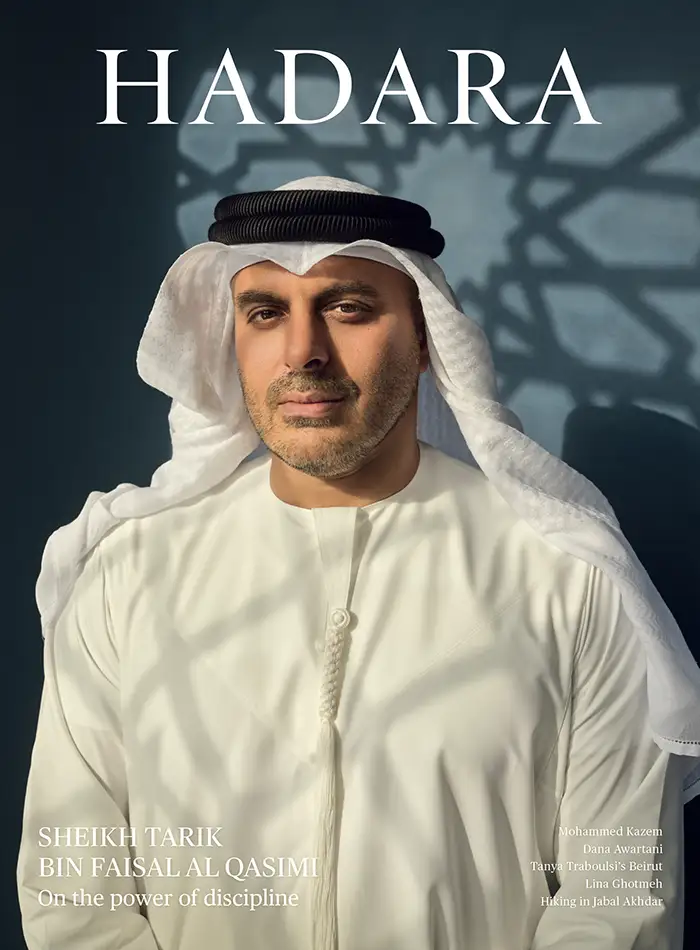Factoring in the Future
A home in Kuwait marries modern minimalism and traditional techniques.
By Helen Jones
Photographs by Nelson Garrido
Pixel House, the latest project by AGi architects, a practice split between Spain and Kuwait, is a proof of concept of ideas co-founders Nasser Abulhasan and Joaquín Pérez-Goicoechea have been playing with since they first met at Harvard’s Graduate School of Design. These include culture, connection, climate, environment, and sustainability, by which AGi not only mean ener- gy use or materials, but the way buildings should be designed to meet a client’s actual needs—now and in the future.
“We rarely follow wish lists,” Abulhasan says. “They don’t teach us this at university, but architects have to be psychologists. When you dig [into the client’s needs] you begin to develop a new list related to their actual life, and not just to their current life but to how they would like to grow into the house, and how the house could influence or encourage better social interaction.”
In Pixel House, that is expressed in a commitment to openness, transition, and permeability, but in ways suited to Kuwait’s climate and cultural norms.
Visually, Pixel House is minimal. Its layers of white ceramic and aluminium lattice-clad slabs nestle in expansive, climate-specific gardens. Despite its heft, the monolithic second storey, which shelters the private areas, seems to float above a row of recessed windows partially hidden behind the curtains of greenery cascading down from the equally hefty overhang shading the lower level. This in turn seems to rest on a wall of slender, perforated metal screens—which create the pixelated light that gives the house its name—that can be folded away to open the view into the gardens.
Together with overhead louvres and metal screens, this overhang acts as a filter, regulating the entry of light and heat into the house and casting patterns of shade on snug terraces and a façade-length lap pool. With its gardens offering additional protection from outside eyes, the lower level of the house blurs the line between inside and out, its multiple changes in level and strategically placed storage and staircases minimise the need for walls to create privacy by carving a series of enclosed and semi-open “rooms” out of what would otherwise be an unrepentantly open-plan house. Protected from the worst of the sun, these spaces, cocoon-like and yet maintaining the sense of flow via internal and external view lines, take advantage of the cooler hours when indoor life can just as easily be moved out.
As Abulhasan and Pérez-Goicoechea demonstrate, when approached properly, the indoor- outdoor lifestyle works perfectly in this seemingly unforgiving climate.
“People still want to live in air-conditioning, but the moment you show them that they could live or spend time outdoors, even in summer, suddenly they say, ‘this is fantastic’,” Pérez-Goicoechea says. “We’re not saying our houses are not air-conditioned, just that they are air-conditioned more sensitively, because their orientation towards the sun and the prevailing wind is all carefully calculated.”
As little as 60 years ago, thick mud-brick walls kept traditional courtyard houses private and cool, enabling Kuwaitis to spend more time outdoors than many do today. By returning to massing, prioritising orientation, and reimagining the singular courtyard as a series of interconnected voids, AGi enters into a dialogue with that past, even as they move it forward.
“For us, the layers are not just about shielding, but also about allowing you to be outdoors. You live in between the layers instead of using them as a barrier,” Abulhasan explains. “It works quite well culturally because it also creates the sense of privacy needed between the inside and the outside, between neighbours and inhabitants, as well as between the inhabitants themselves.”



